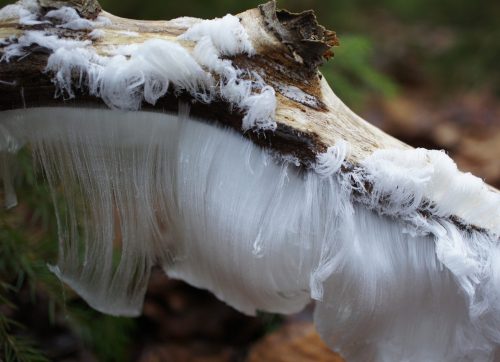Hair IceIf you’ve ever had the chance to hike into a boreal forest on a midwinter morning, you might
Hair IceIf you’ve ever had the chance to hike into a boreal forest on a midwinter morning, you might have seen these glistening, filamentous strands in clumps on the forest floor or wrapped round woody branches. These cotton candy-like fibers are “hair ice” — delicate strands of ice that grow from the insides of rotting tree branches. Hair ice is incredibly fine — just 0.01 millimeters in diameter — and forms from water caught inside plant stems as surrounding temperatures fall below freezing point. Because water expands when frozen, the ice crystals are squeezed through the microscopic orifices of its stemmed container, forming the threadlike fibers as seen in the photos below.Hair ice was first studied by Alfred Wegener (the same Alfred Wegener who proposed the theory of continental drift), and he observed that the ice formed when the mycelium of a fungus was present. The mycelium is the roots of a fungus that wraps around rotting wood in a cocoon-like structure to absorb nutrients. Only recently have researchers have ascertained that the mycelium of certain fungi helps keep the hair ice in place as it grows, and the next step would be to determine the mechanics between the presence of fungi and their influence on hair ice formation.-DCPhoto credits: http://bit.ly/1E477cHMore reading: http://bit.ly/1OJIXJThttp://bit.ly/1JGEdpdhttp://bit.ly/1K0hPmoWatch a time-lapse video of hair ice growing from dead wood: http://bit.ly/1JATNOAOriginal sources:http://www.biogeosciences.net/12/4261/2015/bg-12-4261-2015.htmlhttp://bit.ly/1LwxCPI -- source link
Tumblr Blog : the-earth-story.com
#science#nature#hair ice#fungus#mushroom#mycelium#coccoon#clump#strand#forest#fiber#biology#organism

